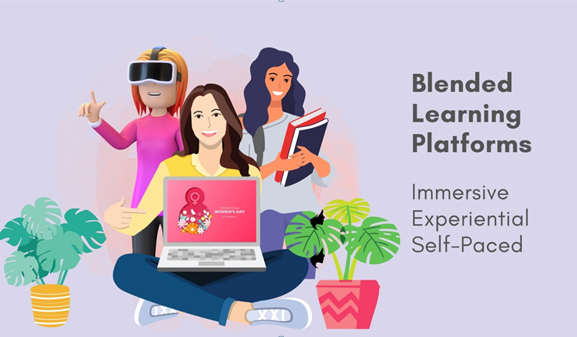Blogs
Blended Learning as a tool of empowerment for women
Blended learning, a new pedagogical methodology, has gained popularity in higher education recently. Zhang et al. (2008) found that, in most cases, women were more inclined towards blended learning than men.

information sharing. This personal feedback provides a balance to the de-personalized computer-assisted learning unit and compensates for the isolated learning process.
Blended learning is not just characterized by technology, as the integration of group work and in-class phases, along with tele tutoring, can facilitate the "de-technization" of computer applications. This approach can enhance the identification of female abilities, such as creativity, communication skills, and teamwork. The combination of learning scenarios can reduce fears of contact through group dynamics and tele tutoring, which leads to an increase in acceptance of this teaching method. Blended learning can also help women cope with difficulties related to technology and improve their motivation to learn.
Additionally, blended learning can help address the gender gap in technology by providing women with the necessary skills and knowledge to succeed in various fields. Women are underrepresented in technology-related industries, and this gap can be reduced through programs that offer blended learning. By providing a supportive and collaborative learning environment, blended learning can empower women to take on leadership roles and succeed in their careers.
Challenges in implementation
However, the implementation of blended learning is not without its challenges. In a study of blended learning in higher education, instructors reported challenges related to technical issues, student engagement, and managing course content (Garrison & Kanuka, 2004). Additionally, blended learning may exacerbate existing disparities in access to technology and resources for students from disadvantaged backgrounds (Dolan et al., 2018).
Despite these challenges, the benefits of blended learning have made it an increasingly popular approach to education globally. According to a report by Research and Markets, the global market for blended learning is expected to reach $12.81 billion by 2023 (Research and Markets, 2018).
As the world's population continues to grow, the importance of agriculture has become more apparent than ever. In India, agriculture is a critical part of the economy, providing employment to millions of people and contributing significantly to the country's GDP. As the industry has evolved, so too has the need for education and training in agriculture. The evolution of blended learning ecosystems has enabled higher education in agriculture to become more effective, efficient, and accessible for students in India.
The Importance of Blended Learning Ecosystems in Indian Agriculture Education
In India, agriculture education is critical to the success of the industry. The country is home to some of the world's most fertile farmland, and agriculture plays a significant role in the economy. However, the industry faces several challenges, including a lack of modern technology and infrastructure, limited access to financing, and a shortage of skilled labor. Blended learning ecosystems can help address these challenges by providing students with access to the latest technologies, resources, and training.
Benefits of Blended Learning Ecosystems in Indian Agriculture Education
- Access to a Wide Range of Resources: A blended learning ecosystem provides students with access to a wide range of resources, including online lectures, simulations, and case studies.
- Increased Flexibility: Blended learning ecosystems offer students greater flexibility in terms of learning time and pace. This allows students to work around their schedules and learn at their own pace.
- Hands-On Experience: Blended learning ecosystems enable students to gain hands-on experience through simulations and other digital resources.
- Reduced Costs: Blended learning ecosystems can reduce the cost of education by eliminating the need for expensive textbooks and reducing the need for travel.
- Improved Learning Outcomes: Blended learning ecosystems have been shown to improve learning outcomes by providing students with more engaging and interactive learning experiences.
In conclusion, the evolution of blended learning ecosystems can enable higher education in agriculture to become more effective, efficient, and accessible for students in India. By providing access to a wide range of resources, increasing flexibility, offering hands-on experience, reducing costs, and improving learning outcomes, blended learning ecosystems have the potential to revolutionize agriculture education in India. As the industry continues to evolve, it is essential that educators embrace this approach to ensure that students are equipped with the skills and knowledge they need to succeed in the agriculture sector.
Bibliography:
Allen, I. E., & Seaman, J. (2020). Digital learning compass: Distance education enrollment report 2017. Babson Survey Research Group.
Dolan, R. P., & Connelly, S. (2018). Disrupting class, but not inequality: The role of race, gender, and socioeconomic status in MOOCs. Harvard Educational Review, 88(3), 365-393.
Garrison, D. R., & Kanuka, H. (2004). Blended learning: Uncovering its transformative potential in higher education. The Internet and Higher Education, 7(2), 95-105.
Market Research (2022). Online Education Market in India 2022-2027. https://www.marketresearch.com/Netscribes-India-Pvt-Ltd-v3676/Online-Education-India-32528950/
Means, B., Toyama, Y., Murphy, R. F., Bakia, M., & Jones, K. (2013). Evaluation of evidence-based practices in online learning: A meta-analysis and review of online learning studies. US Department of Education.
National Center for Education Statistics. (2020). Fast facts: Distance learning. https://nces.ed.gov/fastfacts/display.asp?id=80
O'Neal, C. W., Quinlan, J., & Supanc, M. (2018). Blended learning in STEM: A review of emerging research. Journal of Research on Technology in Education, 50(3), 290-306.
Wiepcke, Claudia & Mittelstädt, Ewald & Liening, Andreas. (2008). Blended Learning Approaches to Enhance Gender Mainstreaming. Asian Women. 24. 21-41.
Zhang,G., Dang, M., Amer, B. and Trainor, K. (2018). Who Favor Blended Learning More: Men or Women? An Explorative Study on Gender Differences. PACIS 2018 Proceedings. https://aisel.aisnet.org/pacis2018/1